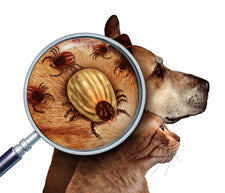Ever see your dog unable to stand or walk, literally going limp under legs like noodles? It could be your dog has Lyme disease and needs immediate medical attention. Recognizing the signs of this serious, but treatable, disease can help you take prompt action and minimize the damage it can cause.
Causes of Lyme Disease
Lyme disease in humans was first discovered and named in 1975 in Lyme, Connecticut. The disease originates as an organism that is spread by ticks. Small mammals carry the bacteria, the ticks feed on the mammals, and humans and dogs contract the disease when they are bitten by infected ticks.
Deer ticks are the most common source of Lyme disease, but other ticks can pass it along too. Certain areas of the U.S. have a higher concentration of the disease. Human cases of Lyme disease collected by the Centers of Disease Control suggest that 85% of cases are from Eastern coastal states, 10% from the Midwest, 4% from Western states and 4% from the rest of the country. It is suggested the incidents of Lyme disease in dogs follow this same pattern.
Lyme disease in animals is most common in dogs, without bias to dog breed or sex. Hunting dogs and other outdoor dogs are most likely to be exposed to ticks carrying the disease. Puppies seem to have a higher risk. However, it is thought that less than 5% of dogs exposed to Lyme disease ever develop clinical signs. If you live in one of the high-risk areas of the country, you should talk to your veterinarian about getting a Lyme disease vaccination.
Signs of Lyme Disease
The most consistent sign of your dog having Lyme disease is lameness with swollen joints that are warm to the touch. The disease can also affect your dog’s heart, nervous system and kidneys.
- Other signs to watch for include:
- Reluctance to get up and move from a laying position
- Fever and/or swelling in one or more joints
- Loss of appetite
- Being drowsy, dull or unenergetic
- Recurring lameness in a joint after complete recover
Treatment of Lyme Disease
If your dog is showing these any of these signs, especially if he has been exposed to ticks, your dog needs to get to a veterinarian as soon as possible. Your vet will probably perform a blood test to confirm exposure to the disease, and possibly analyze some joint fluid to determine the cause of joint inflammation.
Treatment of Lyme disease will be on an individual basis, depending on the severity of your dog’s case. In the early stages of Lyme disease, treatment with antibiotics is usually successful in the first 24-48 hours, but the antibiotics would be continued for 2-4 weeks.
Further Steps
There are many other medical problems that can lead to signs commonly encountered in Lyme disease, so it’s important to get a full analysis by your veterinarian. Some examples would be degenerative joint disease, arthritis, muscle or bone injury or systemic lupus.
There can also be recurring systems after your dog has been diagnosed and treated for Lyme disease. Ask your veterinarian for more information on this disease, or learn more at the Centers for Disease Control and Prevention.
This blog is brought to you by Under the Weather®, provider of bland diet products for dogs. These bland diet products offer a quick and convenient solution when dogs experience digestive issues such as vomiting or diarrhea. Ready to go in minutes – just add boiling water to rehydrate.
Our bland diet recipes are made with 100% human-grade meats – no meat by-products, antibiotic free and no hormones added! They are gluten free and have no chemicals or dyes. Sourced and manufactured in the U.S.A.
View Our Products
Visit Our Blog Library




